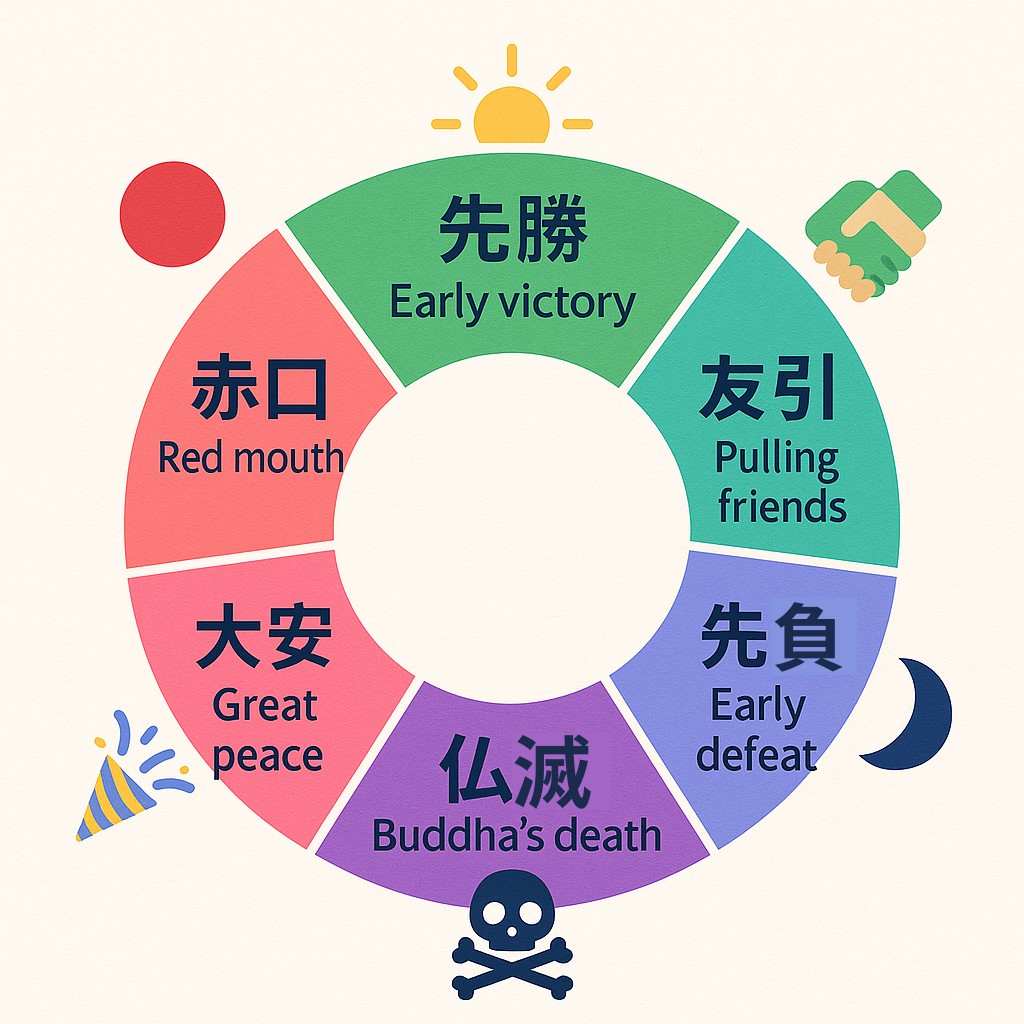
What is the Rokuyō calendar ?
The Rokuyō (六曜) is a traditional Japanese calendar system that assigns a fortune—ranging from good to bad—to each day, cycling through six distinct types. While not based on scientific evidence, Rokuyō remains influential in Japan, especially when selecting dates for significant life events like weddings, funerals, and business openings.
The Six Rokuyō Days
These six days rotate in a fixed sequence on the calendar. The day that starts the cycle resets at the beginning of each lunar month, based on a traditional rule : the first day of each lunar month is assigned a specific Rokuyō based on the month’s number. So, for example: In the 1st lunar month, the 1st day is always Senshō (January 29th for 2025). In the 5th lunar month (May 27th for 2025), the 1st day is always Taian. Then the cycle continues from there in its 6-day loop.
☀️ 先勝 (Sakigachi / Senshō) – “First Victory”
Favorable in the morning; less so in the afternoon.
🤝 友引 (Tomobiki) – “Pulling Friends”
Generally lucky, except around noon.
🌙 先負 (Senbu / Sakimake) – “First Defeat”
Unlucky in the morning, better in the afternoon.
☠️ 仏滅 (Butsumetsu) – “Buddha’s Death”
Considered the most inauspicious day.
🎉 大安 (Taian) – “Great Peace”
Considered the most auspicious day.
🔴 赤口 (Shakkō) – “Red Mouth”
Generally unlucky, except for a brief period around midday (approximately 11 a.m. to 1 p.m.).
Check current Rokuyō on the bottom of this page!
Origins of Rokuyō
Rokuyō is derived from a Chinese divination system used in the Yin-Yang philosophy and calendar calculations.
The concept was introduced to Japan during the Muromachi period (14th–16th century) through the adoption of lunisolar calendars from China. During the Edo period (1603–1868), Rokuyō began to appear more commonly in popular almanacs and calendars. Its use became widespread in the Meiji period, when calendar printing became standardized and the Rokuyō designations were included as part of everyday planners.
How to plan your day using Rokuyō
🎉 大安 (Taian) – “Great Peace”
- Meaning: the luckiest day
- ✅ Do
- Get married
- Open a business
- Start a new job or project
- Move to a new house
- Get married
- ❌ Avoid: nothing — it’s good all day
🤝 友引 (Tomobiki) – “Pulling Friends”
- Meaning: Luck is shared, but not ideal for funerals
- ✅ Do:
- Celebrations, weddings, shopping
- Meetings and social events
- Celebrations, weddings, shopping
- ❌ Avoid:
- Funerals — superstition says it may “pull friends” into death
☀️ 先勝 (Senshō) – “Morning Victory”
- Meaning: Luck is better in the morning, bad in the afternoon
- ✅ Do:
- Important tasks before noon
- Quick decisions or actions
- Important tasks before noon
- ❌ Avoid:
- Major events after 2 p.m.
🌙 先負 (Senbu) – “Morning Defeat”
- Meaning: Unlucky in the morning, better in the afternoon
- ✅ Do:
- Relax or avoid risk in the morning
- Schedule activities after 2 p.m.
- Relax or avoid risk in the morning
- ❌ Avoid:
- Conflict or rushing things early in the day
☠️ 仏滅 (Butsumetsu) – “Buddha’s Death”
- Meaning: Most inauspicious day
- ✅ Do:
- Stay low-key
- Handle simple or private matters
- Sometimes used for sales (to be different!)
- Stay low-key
- ❌ Avoid:
- Weddings
- Business launches
- Major life events
- Weddings
🔴 赤口 (Shakkō ) – “Red Mouth”
- Meaning: Generally unlucky, except around 11 a.m.–1 p.m
- ✅ Do:
- Time-sensitive actions only at midday
- Time-sensitive actions only at midday
- ❌ Avoid:
- Most events outside that lucky window
- Conflicts
Cultural significance today
Rokuyō is still present in daily life in Japan, mainly through its appearance on calendars. While most people don’t actively check it for everyday tasks, they might glance at it when scheduling something important, like a meeting or visit. It functions much like a horoscope — not taken too seriously, but considered by some “just in case.”
The importance of Rokuyō varies by age. Older generations tend to observe it more seriously, particularly for funerals and formal events. Younger people are generally less strict about it but may still consider it for key milestones like weddings or moves. Even if they don’t fully believe in it, many follow it out of habit, respect for elders, or cultural continuity.
Weddings are one of the occasions where Rokuyō is most strongly observed. Couples and wedding planners often aim for Taian, the most auspicious day, believing it will bring luck to their marriage. In contrast, Butsumetsu is avoided by many. However, some couples choose Butsumetsu days intentionally to save money, as venues often offer discounts due to the date’s reputation.
In funeral planning, Tomobiki days are traditionally avoided because of the belief that the deceased might “pull friends along.” This custom is still widely respected, and some crematoriums even close on Tomobiki days. The practice is especially important to older generations, who tend to follow traditional customs more closely.
For new business ventures, many small business owners still consider Rokuyō, particularly choosing Taian for store openings, contract signings, or product launches. While larger corporations often ignore Rokuyō, it still plays a role in client-facing decisions where tradition matters — especially in industries like real estate, bridal services, and hospitality.
